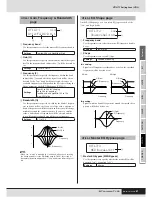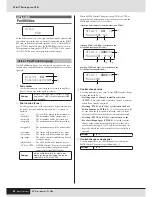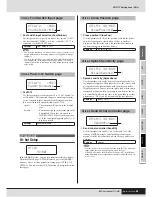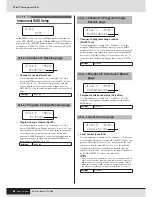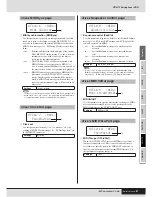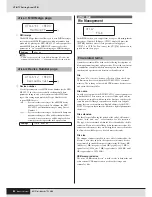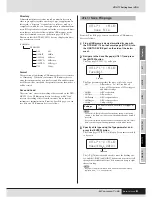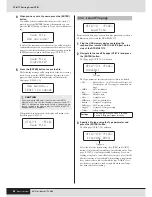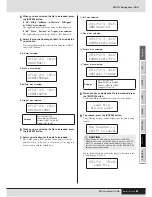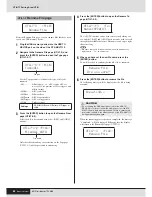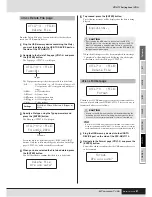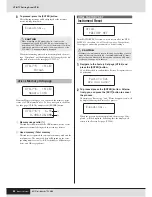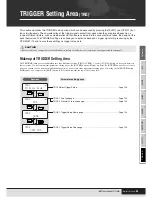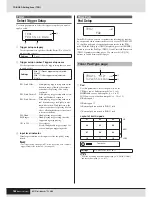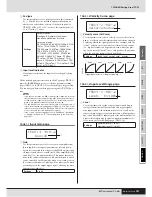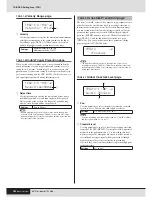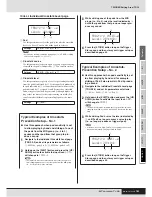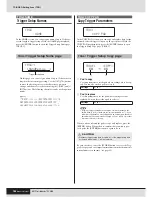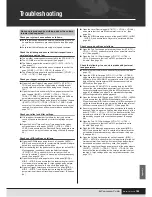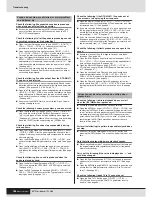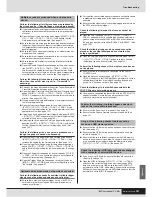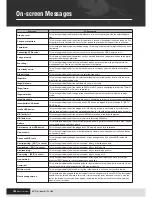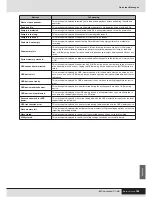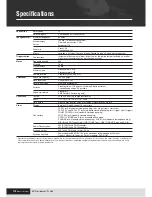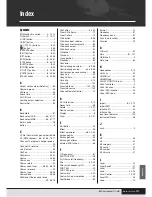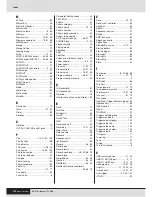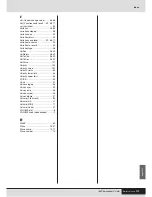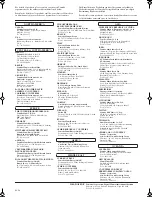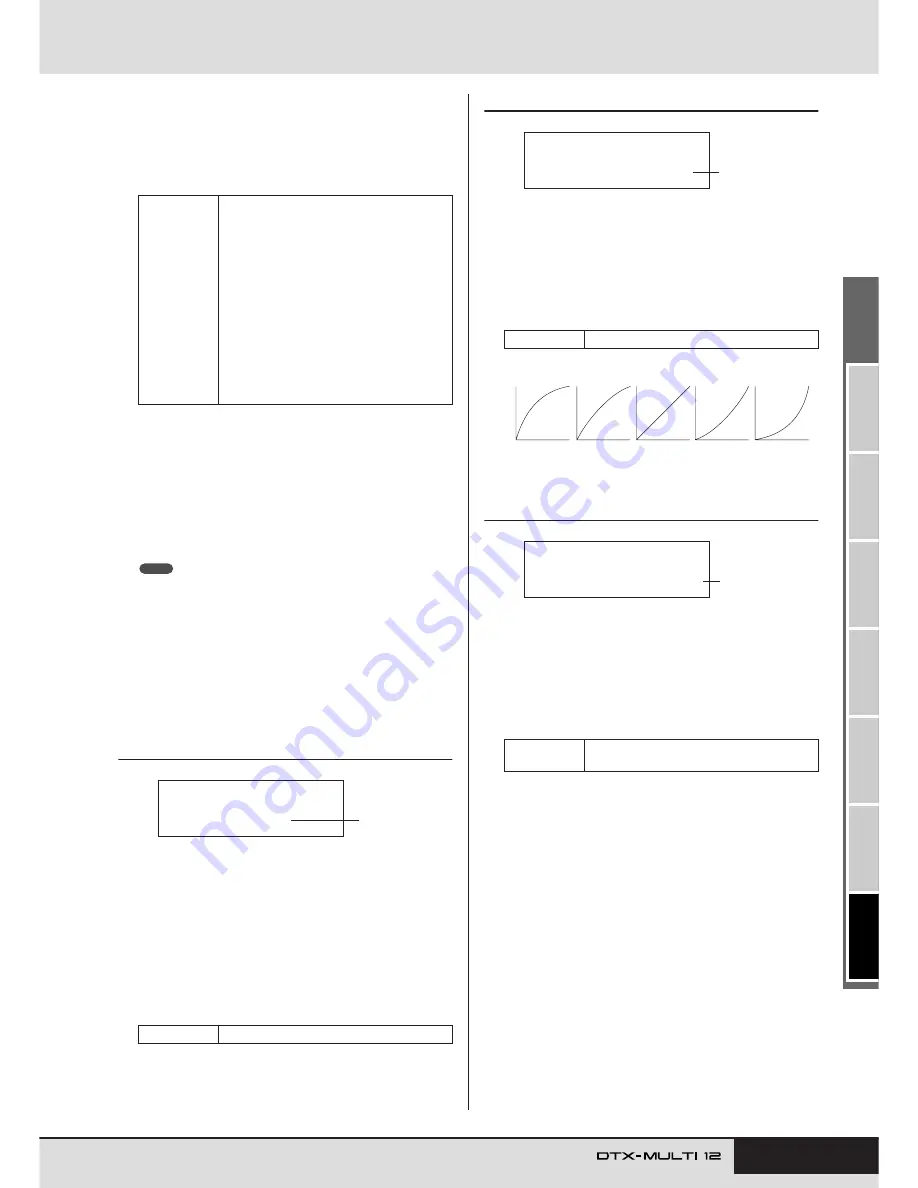
TRIGGER
Ref
erence
KIT
MIDI
V
OICE
UTILITY
W
A
VE
PA
TTERN
TRIGGER Setting Area (TRG)
Owner’s Manual
101
B
Pad type
Use this parameter to set a pad type for the pad(s) indicated
by
1
. Listed below, the available options will depend on
whether you selected one or more of the built-in pads (i.e.,
UP, MID, LOW, or 01 to 12) or one of the external pads (i.e.,
13 to 17) using
1
above.
C
Input level indicator
Visual representation of the input level for the pad(s) being
struck.
With a pad and pad type selected on the Pad Type page (TRG2-1),
press the [ENTER] button to access the five parameter setting
pages (TRG2-1-1 to TRG2-1-5) for that pad type’s trigger setup.
You can navigate between these pages using the [
B
]/[
C
] but-
tons.
• If you have selected the UP, MID, or LOW group of pads, the values ini-
tially shown on each parameter-setting page will correspond to those
for Pad 4 and 10, respectively. In such a case, furthermore, changes
made to any parameter will affect all pads in the group.
• The pad indicator and input level indicator shown on the upper row of
text on the five parameter-setting pages (TRG2-1-1 to TRG2-1-5) are
identical to those from the Pad Type page (TRG2-1). Accordingly, they
are not covered in the following page descriptions.
• If one or more of the built-in pads are set to “HandDyna”, “HandNorm”,
or “HandR”, the Hand icon (
) will be displayed on the Select Kit
page (KIT1).
TRG2-1-1
Input Gain page
1
Gain
Use this parameter to set the level of gain (or amplification)
that is applied to the input signal from the selected pad(s)
before it is converted into a trigger signal. With a high setting,
all input signals above a certain level will be amplified to the
same level (i.e., the maximum level). This means that varia-
tions in the softness or hardness with which the pad is struck
can be smoothed out. Meanwhile, when a low setting is used,
the softness or hardness of playing will be reflected to a much
greater degree in the output trigger signal, allowing for more
expressive performances.
TRG2-1-2
Velocity Curve page
1
Velocity curve (VelCurve)
Use this parameter to select a velocity curve for the selected
pad(s). A velocity curve determines how the relative strength
of playing affects the signal produced. For example, with the
“loud2” velocity curve shown below, relatively loud sounds
(i.e., high velocities) can be produced even with softer play-
ing. In contrast, the “hard2” curve only produces loud sounds
when the pad in question is struck quite hard.
TRG2-1-3
Input Level Range page
1
Level
Use this parameter to set the range of input signals (in per-
centage format) that will be converted into trigger signals.
Any input signals at the minimum level or lower will not be
converted into a trigger signal, and therefore, will not produce
any sound. Meanwhile, input signals at the maximum level or
higher will result in trigger signals with the maximum veloc-
ity as set on the Velocity Range page (TRG2-1-4).
Settings
For built-in pads
StickDyna, StickNorm, StickNarrow,
HandDyna, HandNorm, or Hand
For external pads
KP125W/125, KP65, XP120/100Sn, XP120/
100Tm, TP120/100Sn, TP120/100Tm,
TP65S Snare, TP65S Tom, TP65S HiHat,
TP65, PCY155, PCY135, PCY150S,
PCY130SC, PCY130S/130, PCY65S/65,
RHH135, RHH130, DT Snare, DT HiTom,
DT LoTom, DT Kick, TRG Snare 1, TRG
Snare 2, TRG Snare 3, TRG HiTom 1, TRG
HiTom 2, TRG LoTom 1, TRG LoTom 2, TRG
Kick 1, or TRG Kick 2
Settings
0 to 63
NOTE
ˇÁ
TRG2-1-1≥-MID-˛¸
≥≥≥≥Gain=30
1
Settings
loud2, loud1, normal, hard1, or hard2
Settings
Minimum level: 0% to 99%
Maximum level: 1% to 100%
TRG2-1-2≥-MID-˛¸
VelCurve=normal
1
loud2
loud1
norm
hard1
hard2
V
elocity
Trigger input level (i.e., strength of playing)
→
TRG2-1-3≥-MID-˛¸
Level=≥≥≥0%-100%
1
Содержание DTX-MULTI
Страница 1: ...Owner s Manual EN ...
Страница 114: ...114 Owner s Manual MEMO ...

